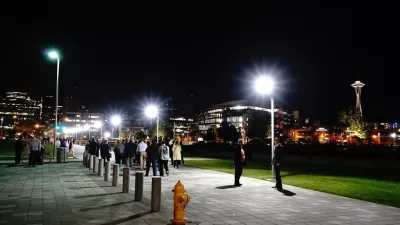Is it mid-March already? I’m far overdue for announcing my departure from Planetizen, which happened at the tail end of 2011. It was a wonderful 3 ½ years at the helm, and I thank Chris Steins and Abhijeet Chavan for giving me the opportunity back in 2008 to steer this incomparable resource.
Is it mid-March already?
I'm far overdue for
announcing my departure from Planetizen, which happened at the tail end of
2011. It was a wonderful 3 ½ years at the helm, and I thank Chris Steins and
Abhijeet Chavan for giving me the opportunity back in 2008 to steer this incomparable
resource.
One of the most interesting aspects of editing Planetizen was the birds-eye
view of urban planning and its internal debates. Planetizen's policy has always
been to encourage commentary from all sides, including those deemed unpopular
by the majority of the field. I admire this journalistic policy, and as I
depart I feel the opportunity is ripe to loosen my tongue and add a few
opinions of my own to matters of ongoing debate.
1. Urbanism is for everyone.
I'll
point the finger at Joel Kotkin for this one: he's in large part responsible
for popularizing in the media the confused idea that the suburbs are at war
with the cities. I won't go too deep, but Kotkin's definitions are flawed and out of date. It's easy to say everyone wants to live in the
suburbs when you define the suburbs as everything smaller than a skyscraper.
Beyond
the definitional confusion, the debate seems like a complete distraction from
what is happening on the ground today, which as I see it, is an acceptance of the definition of good urbanism at all
levels of density - city, small town or rural. Whatever you want to call
it, practitioners are embracing walkability, mixing uses and creating quality
places for people to come together. The decades-long rejection of the public
realm in favor of convenient parking is mostly, finally over.
2. Traditionalists need to get over themselves.
I'm going out on a limb on this one, because I have
many friends in CNU that embrace the idea that traditional architecture and
planning are the only tried-and-true way to build quality places. I understand
the sentiment – there is a lot of crappy construction out there, and there are
a handful of folks in academia who are too wound up in the esoterica of avant-garde
architecture and design. But rejecting new ideas in architecture as a whole is
throwing out the baby with the bathwater.
You can preserve the basics of good urbanism that we all agree on and
still create sexy buildings that are (heavens!) modern in style. David Baker + Partners in San Francisco, to name just one, is doing excellent contemporary,
affordable designs that people love, and that are on-target urbanistically.
3. Gentrification is the life cycle of a thriving city.
If
a city is going to be healthy economically, there will always be neighborhoods
that are revitalized and brought up from poverty, and populations will
shift. Some concerns about displacement
are appropriate, and communities need to have the levers in place to help
people stay in their communities and contribute to revitalization. But in some
cities, anti-gentrification forces actually prevent economic development and
urban vitality. Done properly, a rising tide can raise all, or at least most,
ships. It would be a true shame, as we pull ourselves out of the economic
recession of the last few years, if a small force of anti-gentrification
advocates managed to prevent much-needed economic investment in underdeveloped
urban communities, thus doing a disservice to those communities as they are
left to wither.
Barbs and strong opinions welcome (I'm waiting for you, Dano).
Please make new managing
editor Jonathan Nettler feel welcome.
I've met with him a few times since he took the reins, and I feel like
Planetizen is in very capable hands.
I'm also pleased to report
that I'm working now for an exciting new venture with the ever-inspiring Carol
Coletta called ArtPlace.
ArtPlace is a collaboration of eleven of the nation's top foundations, eight
federal agencies including the National Endowment for the Arts, and six of the
nation's largest banks. The motivating theory behind ArtPlace is that art,
culture and creativity create vibrancy and increases economic opportunity.
That's a mission I can get behind.
I'll always be an "editor
emeritus" of Planetizen, and will try to blog regularly.
After all these years, I still feel strongly that we, as urbanists, are one of
the only fields that truly have holistic solutions for saving the world. Amid
the debates and endless public meetings, we should celebrate that and always
hold true to our knowledge and our ideals.

Planetizen Federal Action Tracker
A weekly monitor of how Trump’s orders and actions are impacting planners and planning in America.

Map: Where Senate Republicans Want to Sell Your Public Lands
For public land advocates, the Senate Republicans’ proposal to sell millions of acres of public land in the West is “the biggest fight of their careers.”

Restaurant Patios Were a Pandemic Win — Why Were They so Hard to Keep?
Social distancing requirements and changes in travel patterns prompted cities to pilot new uses for street and sidewalk space. Then it got complicated.

Platform Pilsner: Vancouver Transit Agency Releases... a Beer?
TransLink will receive a portion of every sale of the four-pack.

Toronto Weighs Cheaper Transit, Parking Hikes for Major Events
Special event rates would take effect during large festivals, sports games and concerts to ‘discourage driving, manage congestion and free up space for transit.”

Berlin to Consider Car-Free Zone Larger Than Manhattan
The area bound by the 22-mile Ringbahn would still allow 12 uses of a private automobile per year per person, and several other exemptions.
Urban Design for Planners 1: Software Tools
This six-course series explores essential urban design concepts using open source software and equips planners with the tools they need to participate fully in the urban design process.
Planning for Universal Design
Learn the tools for implementing Universal Design in planning regulations.
Heyer Gruel & Associates PA
JM Goldson LLC
Custer County Colorado
City of Camden Redevelopment Agency
City of Astoria
Transportation Research & Education Center (TREC) at Portland State University
Camden Redevelopment Agency
City of Claremont
Municipality of Princeton (NJ)






























